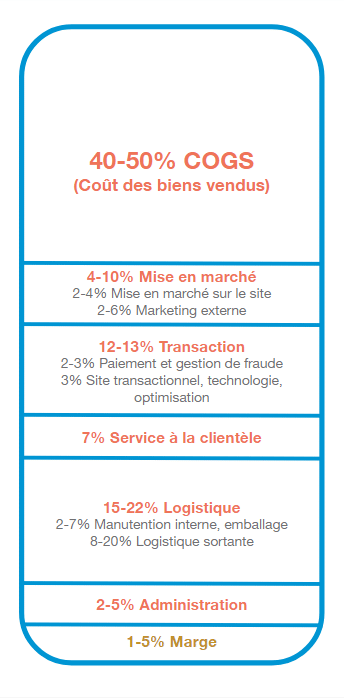Digital Transformation Strategy Consultant
Acquisition in e-commerce: structuring your due diligence
Digital Transformation Strategy Consultant
The issue of digital transformation can take many forms. We could take as an example a company that operates in a very specific sector and that aspires to modify its business model in order to engage in electronic commerce. In such a case, why not simply consider acquiring a third-party company in its sector of activity that already does e-commerce? While this idea may seem simple at first glance, it raises several considerations to consider in what is called due diligence .
This article does not state the art of the activities inherent in a due diligence in its entirety, but rather what one must look at with regard to digital.
WHAT DO WE WANT TO OBTAIN BY THIS ACQUISITION?
First of all, it is important to fully understand the buyer's strategy when faced with this acquisition. On the one hand, what is its scope, and on the other, what actions will be taken following its acquisition? This information is essential in order to focus on the right diagnostic variables. Do we want to acquire an ecosystem? A customer database? A name and notoriety?
WHERE TO START?
We recommend starting with a modeling of the ecosystem as a whole and getting a head on the assets at the level of marketing, sales channels or even operations and logistics, but above all, understanding the interactions and connections between different systems. It is also important to highlight, through this same modeling, the initiatives that revolve around e-commerce such as the customer database, the presence, or not, of a marketing automation mechanism, etc.
Another interesting analysis at this stage, especially if the company to be acquired operates mainly online, is to fully understand its business model. To do this, the business model canvas of Osterwalder and Pigneur can be used to comply with a standard and a more precise framework.
WHO SAYS TRADE, SAYS INCOME
It is not without recalling that a successful company in e-commerce is a company that can be characterized by:
- A higher proportion of online sales than comparables ;
- Online sales growing faster than comparables :
- Growth/online sales that do not cannibalize other channels (too much) ;
- An omnichannel that helps increase margins ;
- Satisfied omnichannel customers and an omnichannel that contributes to a customer's lifetime value .
We therefore propose to continue by carrying out the analysis of the income generated by digital assets. How much do digital sales represent compared to overall revenue? How are revenues generated? We must not forget that the site may represent only a part of online sales. It is essential to take into consideration the ecosystem in its entirety and the different digital channels used (site, marketplaces, etc.).
Understanding current revenues (eg those generated in the last year) is one thing, but understanding their evolution over time is essential. It is certain that this analysis always depends on the history of the company, but it seems optimal to us to look at the trend over as many years as possible according to the data available.
It is also recommended to consider the growth of the brand under study in relation to its industry. For the growth of the industry, different sources can be tapped. eMarketer and several other publications regularly share indexes on the average growth of Canadian and international online retailers. It then becomes possible and relatively easy to cross-reference this data with that of the brand under study to validate whether the growth is significant. The Internet retailer , on the other hand, gives more precise comparables according to the industry concerned.
Once the revenues have been analyzed, it may be wise to dwell on the fundamental elements of e-commerce, namely: orders , products , customers and the organization . These are a great way to orchestrate the next steps in our due diligence.
THE ENEMY OF TOMORROW'S INCOME IS TODAY'S INCOME.
Jean-Francois Renaud, Adviso
NO REVENUE WITHOUT ORDERS
The analysis of orders is important in order to better understand the volume in relation to the scope of the brand under study. You can consider different measures, such as:
- Number of total transactions;
- Number of transactions per day;
- Average number of items per order;
- Average basket value;
- Conversion rate.
As with revenue, it is important to understand the evolution of the conversion rate and the average basket. This analysis will provide a better idea of the relevance of the efforts made to optimize these two variables. Is the average basket value increasing? Is the conversion rate running out of steam? A more in-depth analysis of the distribution of orders (number of sales according to their average values) will provide even more insight into the market in which the company operates.
If these metrics are important, it is just as relevant to look at what the orders look like. An analysis of the latter will ensure that the ambitions of the acquirer can be met quickly, if not immediately. For example, a company that aspires to do B2C e-commerce could be hampered by online sales of the coveted company that turn out to be more B2B oriented… or vice versa.
NO ORDERS WITHOUT PRODUCTS
This is our next variable to study. The product analysis is useful to better understand the scope of the company. Different measures must be considered, such as:
- How many SKUs are present in the catalog?
- How many different products have sold in the last year?
- How is the catalog managed (manually, presence of a Product Information Management (PIM )?
- What is the distribution of products according to their average value?
- Which products generate the most revenue?
Beyond the products, and if the catalog allows it, it may be interesting to carry out this same analysis for the brands and/or categories.
NONE OF THIS WITHOUT CUSTOMERS
Next comes the customer analysis stage : consider an overview of the socio-demographic characteristics available, and, above all, find out if the lifetime value (LTV) is established. Thereafter, we advise to analyze the traffic in a more specific way:
- Which audiences make up the traffic?
- What are the sources of traffic?
- Is a CRM in place and what does it extract as customer data?
The following should be considered:
- Behaviour: how many pages have been visited, what is the bounce rate and the percentage of exits?
- Internal research: what internal research is done? Do these give the expected results? Is the conversion rate proportional?
- Engagement: what is the ratio between new and returning visitors?
- Loyalty: what mechanisms are in place to ensure customer loyalty?
AND THE ORGANIZATION IN ALL THIS?
Another sphere to study is related to the organization . What digital resources are in place (profile, skills, roles and responsibilities, etc.)? There is room for the evaluation of the company's culture, that is to say, the more soft skills side of the resources which, let us underline it, could constitute your team of tomorrow, depending on the scope of the transaction.
By referring to resources, we also imply the notion of actors within different internal processes. It then becomes important to analyze operational processes such as order management, inventory management, etc. in order to detect if activities without added value are carried out there and, consequently, if a reengineering will be necessary.
Finally, we recommend carrying out a technology analysis in order to take stock of current strengths, but especially of the elements to be monitored. Even if best-of-breed solutions generally simplify integration, it is important to keep in mind that an acquisition should not be made solely under the guidance of the technology in place, considering that it can quickly become obsolete. .
COST ANALYSIS
Subsequently, it is important to focus on the cost analysis .  To do this, we propose to analyze what proportions, for each dollar spent on digital, are possible to associate with different types of costs such as COGS, marketing, transaction, customer service, logistics or administrative costs. This analysis not only helps to better understand the margin, but also to see where the biggest sources of expenses are.
To do this, we propose to analyze what proportions, for each dollar spent on digital, are possible to associate with different types of costs such as COGS, marketing, transaction, customer service, logistics or administrative costs. This analysis not only helps to better understand the margin, but also to see where the biggest sources of expenses are.
A simple mapping of proportions can quickly provide insight into cost sources.
When talking about e-commerce, it is also important to comb through the costs associated with returns and chargebacks. In the end, we seek to determine if the distribution is similar to what can be found in the industry and if the investments are made in the right place and in a rational manner.
GATHER FINDINGS AND POSITION YOURSELF
All these reflections will allow us to draw up observations which will be transformed into executive recommendations. The buyer will therefore be guided through the last steps that will lead him, or not, to the purchase transaction. Generally, executive recommendations can be counted on the fingers of one hand and must be broken down into actionable tactics in the short, medium or long term. It is important, at this stage, to position oneself clearly in relation to the acquisition and to draw a parallel with the first stage which, let us remember, consisted in understanding the strategy behind the acquisition. Digital assets can be the best in the world, if they do not respond to the strategy, then the latter will have to be questioned or conclusions drawn that are unfavorable to the final transaction.
Many of the data mentioned earlier may seem difficult to collect to carry out the various analyses, but it is important to keep in mind that a simple Google Analytics, well configured and logged, can give you the answer to all these questions. If such a measurement tool is not in place or does not allow you to respond to the various points, it may be a sign that it would be wiser to pass your turn… Let us guide you further.


.jpg)








